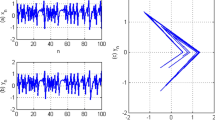Abstract
This paper describes a new interleaver construction technique for turbo code. The technique searches as much as possible pseudo-random interleaving patterns under a certain condition using genetic algorithms(GAs). The new interleavers have the superiority of the S-random interleavers and this interleaver construction technique can reduce the time taken to generate pseudo-random interleaving patterns under a certain condition. The results obtained indicate that the new interleavers yield an equal to or better performance than the S-random interleavers. Compared to the S-random interleaver, this design requires a lower level of computational complexity.
Similar content being viewed by others
References
Berrou C, Glavieux A, Thitimajshima P. Near Shannon Limit Error-correcting Coding and Decoding: Turbo-Codes.Proceedings of the IEEE International Conference on Communications, Geneva: Switzerland, May 1993, 1064–1070.
Briffa J A, Buttigieg V. Interleavering and Termination in Unpunctured Symmetric Turbo Codes.IEE Proceedings Communications, 2002,149(1): 6–12.
Divsalar D, Pollara F. Multiple Turbo Codes for Deep-Space Communication.JPL TDA Progress Report, 1995,42 (121): 66–77.
Eroz M, Hammons A R. On the Design of Prunable Interleavers for Turbo Codes.Proc IEEE VTC'99,Houston, May 1999. 1669–1673.
Shibutani A, Suda H, Yamao Y. Performance of W-CDMA Mobile Radio with Turbo Codes Using Prime Interleaver.Proc VTC'2000, 2000IEEE 51st, 2000, (2): 946–950.
Dolinar S, Divsalar D. Weight Distributions for Turbo Codes Using Random and Nonrandom Permutation.JPL TDA Progress Report, 1995,42(122): 56–65.
Davis L.Handbook of Genetic Algorithms. New York: Van Nostrand Reinhold Press, 1991. 385.
Goldberg D E.Genetic Algorithms in Search, Optimization and Machine Learning. Boston: Addison-Wesley Longman Publishing Co Inc, 1989.
Andrews K S, Heegard C, Kozen D. Interleaver Design Methods for Turbo Codes.Proceedings of the IEEE International Conference on Information Theory, 1998, 16–21, 420.
Author information
Authors and Affiliations
Corresponding author
Additional information
Foundation item: Supported by the National Natural Science Foundation of China (60372057) and the Key Open Laboratory on Information Science and Engineering of Railway Transportation Ministry of Beijing Jiaotong University of China (KLISAE-0103)
Biography: Tan Ying (1963-), female, Associate professor, Ph. D, research direction: error control coding, analysis and design of wireless communication system.
Rights and permissions
About this article
Cite this article
Ying, T., Hong, S. & Huai-bei, Z. Interleaver design method for turbo codes based on genetic algorithm. Wuhan Univ. J. Nat. Sci. 9, 323–326 (2004). https://doi.org/10.1007/BF02907887
Received:
Issue Date:
DOI: https://doi.org/10.1007/BF02907887




